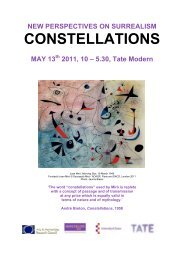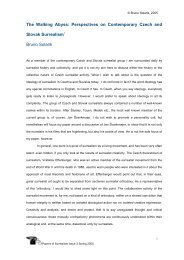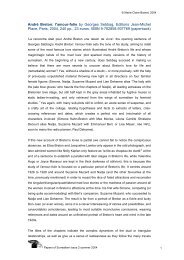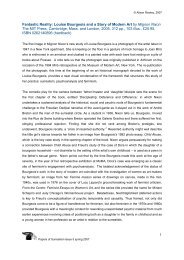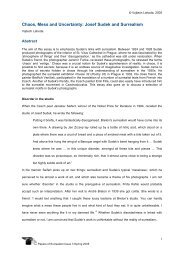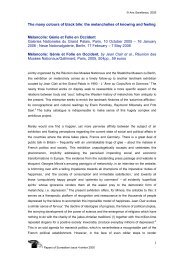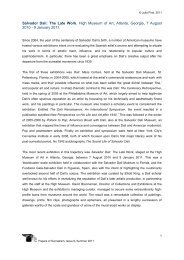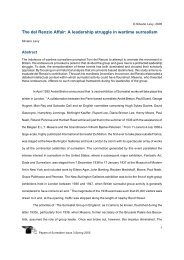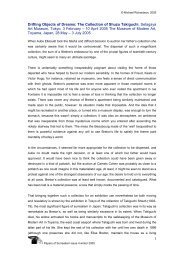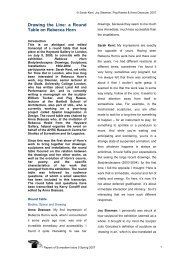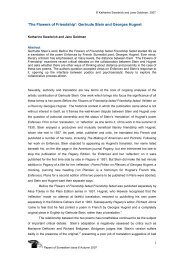From the Walls of Factories to the Poetry of the Street: Inscriptions ...
From the Walls of Factories to the Poetry of the Street: Inscriptions ...
From the Walls of Factories to the Poetry of the Street: Inscriptions ...
You also want an ePaper? Increase the reach of your titles
YUMPU automatically turns print PDFs into web optimized ePapers that Google loves.
© Caroline Levitt, 2011<br />
Brassaï‟s pho<strong>to</strong>graphs <strong>of</strong> graffiti can perhaps even provide us with an approximation <strong>of</strong> <strong>the</strong> type <strong>of</strong><br />
things that Apollinaire was observing. 2<br />
Le Flâneur is both a late text and a neglected one within Apollinaire‟s oeuvre. A sense <strong>of</strong><br />
post-war nostalgia and a taste for <strong>the</strong> marginal are expressed in <strong>the</strong> first section, „Souvenir d‟Auteuil,‟<br />
which recalls <strong>the</strong> <strong>to</strong>ne <strong>of</strong> some <strong>of</strong> his earlier poems published in Alcools (1913): <strong>the</strong> au<strong>to</strong>biographical<br />
„Zone‟ and „Le Pont Mirabeau‟ are especially pertinent examples. The urban peregrinations <strong>of</strong><br />
Apollinaire in <strong>the</strong>se works combine <strong>the</strong> past and <strong>the</strong> present, <strong>the</strong> personal and <strong>the</strong> commercial in<br />
ways that pre-empt Aragon‟s Le Paysan de Paris (1926) or Bre<strong>to</strong>n‟s Nadja (1928). 3 Apollinaire‟s<br />
appreciation <strong>of</strong> graffiti in Le Flâneur is intrinsically connected with his proclamation in „Zone‟ that<br />
advertisements and fragments <strong>of</strong> text are <strong>the</strong> poetry <strong>of</strong> <strong>to</strong>day, and both graffiti and found ephemera<br />
were <strong>of</strong> equal importance <strong>to</strong> <strong>the</strong> surrealists. In an article on film from <strong>the</strong> same year as Le Flâneur,<br />
Aragon wrote <strong>of</strong>: „<strong>the</strong> haunting beauty <strong>of</strong> commercial inscriptions, <strong>of</strong> posters, <strong>of</strong> evocative capitals, <strong>of</strong><br />
very ordinary objects.‟ He praised painters and poets who had noted „hieroglyphs on <strong>the</strong> walls‟ and<br />
stated that „<strong>the</strong>se letters which vaunt <strong>the</strong> value <strong>of</strong> a bar <strong>of</strong> soap are worth as much as <strong>the</strong> characters<br />
on obelisks or <strong>the</strong> inscriptions <strong>of</strong> a book <strong>of</strong> black magic: <strong>the</strong>y speak <strong>of</strong> <strong>the</strong> fate <strong>of</strong> <strong>the</strong> era.‟ 4<br />
<strong>Inscriptions</strong>, whe<strong>the</strong>r graffiti scratched in<strong>to</strong> walls, typography on modern objects or<br />
monumental or talismanic captions fill <strong>the</strong> poetry and imagery <strong>of</strong> <strong>the</strong> twentieth century avant-garde –<br />
Aragon noted, amongst those who had introduced <strong>the</strong>m, Baudelaire, <strong>the</strong> Cubists and, above all,<br />
cinema<strong>to</strong>graphers. This article seeks in <strong>the</strong> first instance <strong>to</strong> demonstrate that Apollinaire and <strong>the</strong><br />
surrealists shared an interest in graffiti, viewing it as valuable in its own right, as more worthy even<br />
than <strong>of</strong>ficial-sounding „inscriptions.‟ The relationship between graffiti and inscriptions is an interesting<br />
one that can be expanded by examining <strong>the</strong>ir etymological roots. The term „inscription‟ comes from<br />
<strong>the</strong> Latin scribere, <strong>to</strong> write, whereas „graffiti‟ stems from <strong>the</strong> Italian graffio, <strong>to</strong> scratch. Writing is a<br />
sophisticated practice, whereas scratching appears crude or perhaps even bestial. Inscribing tends <strong>to</strong><br />
involve <strong>the</strong> use <strong>of</strong> language, whereas graffiti can incorporate pictures <strong>of</strong> varied legibility. In turn,<br />
inscriptions <strong>of</strong>ten refer <strong>to</strong> <strong>of</strong>ficial dedications, perhaps in <strong>the</strong> front <strong>of</strong> a book or perhaps carved more<br />
permanently in<strong>to</strong> s<strong>to</strong>ne, whereas <strong>the</strong> implication <strong>of</strong> „graffiti‟ is that it has defaced something, possibly<br />
even something that has been inscribed in such a way as <strong>to</strong> denote value and importance.<br />
<strong>Inscriptions</strong> come <strong>to</strong> stand for high, monumental practices, whereas graffiti denote low, destructive<br />
ones. It is <strong>to</strong> this linguistic irony that Apollinaire wittily refers when he describes <strong>the</strong> etchings in <strong>the</strong> rue<br />
Ber<strong>to</strong>n as „inscriptions,‟ adding „or graffiti, as <strong>the</strong> antiquarians would say,‟ and thus implying that an<br />
avant-garde appreciation <strong>of</strong> <strong>the</strong> marginal might go somewhat fur<strong>the</strong>r than an antiquated disdain for all<br />
that is not <strong>of</strong>ficial or monumental. Apollinaire seems <strong>to</strong> overwrite a his<strong>to</strong>ry <strong>of</strong> inscriptions with one that<br />
is marginal, personal and ultimately far more exciting, and thus <strong>the</strong> relationship between graffiti and<br />
inscriptions comes <strong>to</strong> stand for a dicho<strong>to</strong>my that will carry through <strong>to</strong> broader <strong>the</strong>mes. Graffiti will be<br />
shown <strong>to</strong> be emblematic <strong>of</strong> a variety <strong>of</strong> un<strong>of</strong>ficial, playful and anti-monumental creative practices, all<br />
<strong>of</strong> which are generally held <strong>to</strong> be at <strong>the</strong> heart <strong>of</strong> surrealism but that were equally present in <strong>the</strong> work <strong>of</strong><br />
Apollinaire. Writing was for both a means <strong>of</strong> transgression and liberation, a way <strong>of</strong> appreciating <strong>the</strong><br />
marginal and personal over <strong>the</strong> <strong>of</strong>ficial and universal and a powerful signifier that could be at once<br />
playful and marvellous.<br />
Papers <strong>of</strong> Surrealism, Issue 9, Summer 2011 2




